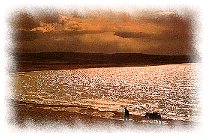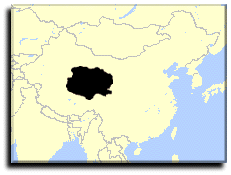The Land Of China -- Explore by Province
Qinghai
 Qinghai
Qinghai
|
The Qinghai Province is located in the western part of China in the North-eastern part of Qinghai-Tibet Plateau. It was named Qinghai because of it contains the largest saltwater lake in China, Qinghai Lake. Covering an area of 720,000 square km, it contains a population of 4,740,000 with 33 different ethnic groups. Its capital is based in Xining.
The Chinese province of Qinghai is a desolate mountain country that serves as a domain of nomadic Tibetan herders, hospitable Buddist monks, and a seemingly endless number of sheep and yaks. Qinghai is also characterized by frigid temperatures, snow-covered roads, and treacherously icy rivers. It is the kingdom of mountains with the Kunlun Mountain Range, the "Roof of Asia", and the Qilian Mountain. Some major rivers, such as the Yangtze River and the Yellow River, rise in the Qinghai Province.
 Qinghai, the Bitter Cold
Qinghai, the Bitter Cold
|
Lakes and marsh swamps on the plateau have their own beauty with abundant wild life inhahitants. The Bird Island in Qinghai Lake serves as a good example, and wild antelope, yak, donkeys, camels, lynx, deer and pheasant roam freely over the vast grasslands. Qinghai has picturesque snow-capped mountains and glaciers with many historical relics and legends left over from the ancient path linking the Tang Dynasty and Tibet. There are many temples in Qinghai and its various religious arts and activities are well known around the world. The highway to Lhasa is asphalted and is the highest highway in the world. The different ethic groups make up a diversified folk customs.
 the Ta'er Lamasery
the Ta'er Lamasery
|
Capital city, Xining (Western Peace), has large lamaseries and mosques to offer. The Ta'er Lamasery is located in Huangzhong County and is one of China's six largest lamaseries of the Yellow sect. Built in 1560 AD, the lamasery combines Han and Tibetan arts and consists of the Great Temple of Golden Tile, the Lesser Temple of Golden Tile, the Great Meditation Hall, the Nine-Room Hall and more. The lamasery contains more than 20,000 religious paintings and embroideries, and its butter sculptures, murals, and appliques are known as "the three wonders of Ta'er" and have unique styles and great artistic value. The Dongguan Mosque, one of the biggest in Northwest China, was built in 1380.
 Qinghai Lake
Qinghai Lake
|
Qinghai Lake, or "Green Lake", is China's biggest salt-water lake with a circumference of more than 360 kilometers and an area of 4,635 square kilometers. It lies in the northeast part of the province and is 130 kilometers from Xining and is 3196 meters above sea level. The lake contains 6 percent salt and has an average depth of 19 meters, while its deepest spot is 30 meters. Many fish swim freely in Qinghai Lake's cold waters. Major sights around the lake are Bird Island, Haixin Hill, Haixi Hill, Sankuaishi (Three stones) and Sand Island.
 Bird Island
Bird Island
|
The 800,000 square meter Bird Island is located northwest of Qinghai Lake, 350 kilometers from Xining. A bird sanctuary, the island attracts 100,000 migrating birds of different species each summer and autumn. A shortage of rain in recent years has caused a drop in water and has made the island a peninsula. This "Kingdom of Birds" has become a natural reserve.
Golmud, a new city in the Gobi desert, is 800 kilometers from Xining. Between the two cities is the Salt Bridge and Salt Pond. The bridge is built entirely of salt.
 the People of Qinghai
the People of Qinghai
|














 Chinese Culture
Chinese Culture